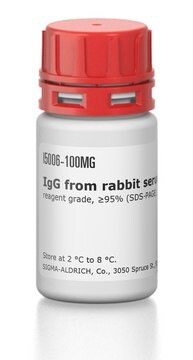A8914
Anti-Rabbit IgG (whole molecule)−Agarose antibody produced in goat
affinity isolated antibody, saline suspension
About This Item
Produits recommandés
Source biologique
goat
Conjugué
agarose conjugate
Forme d'anticorps
affinity isolated antibody
Type de produit anticorps
secondary antibodies
Clone
polyclonal
Forme
saline suspension
Ampleur du marquage
~1 mg per mL
Technique(s)
immunoelectrophoresis: suitable
Matrice
Cross-linked 4% beaded agarose
Activation de la matrice
cyanogen bromide
Espaceur de matrice
1 atom
Capacité
≥0.25 mg/mL, resin binding capacity (rabbit IgG)
Température de stockage
2-8°C
Modification post-traductionnelle de la cible
unmodified
Vous recherchez des produits similaires ? Visite Guide de comparaison des produits
Description générale
Immunogène
Application
Forme physique
Clause de non-responsabilité
Vous ne trouvez pas le bon produit ?
Essayez notre Outil de sélection de produits.
Code de la classe de stockage
12 - Non Combustible Liquids
Classe de danger pour l'eau (WGK)
WGK 1
Point d'éclair (°F)
Not applicable
Point d'éclair (°C)
Not applicable
Faites votre choix parmi les versions les plus récentes :
Déjà en possession de ce produit ?
Retrouvez la documentation relative aux produits que vous avez récemment achetés dans la Bibliothèque de documents.
Notre équipe de scientifiques dispose d'une expérience dans tous les secteurs de la recherche, notamment en sciences de la vie, science des matériaux, synthèse chimique, chromatographie, analyse et dans de nombreux autres domaines..
Contacter notre Service technique






